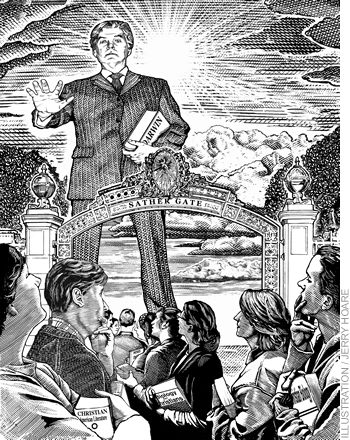 Jordan Trivison is a very active participant in Shannon Jonker’s 12th-grade English class. On one recent morning Jordan recapped in detail several chapters of Mary Shelley’s Frankenstein, which the students had been assigned to read the previous night. When the other seniors at Calvary Chapel high school in Murietta, California, joined in the discussion, the class moved quickly from the question of whether the monster in the novel can be blamed for his behavior—since he was abandoned shortly after his formation, and no one taught him right from wrong—to the more complex issue of “whether the monster has a soul.” Jordan struggled with this issue, noting that, on the one hand, the monster was created by man, and not God, but, on the other hand, he was capable of love and compassion.
Jordan Trivison is a very active participant in Shannon Jonker’s 12th-grade English class. On one recent morning Jordan recapped in detail several chapters of Mary Shelley’s Frankenstein, which the students had been assigned to read the previous night. When the other seniors at Calvary Chapel high school in Murietta, California, joined in the discussion, the class moved quickly from the question of whether the monster in the novel can be blamed for his behavior—since he was abandoned shortly after his formation, and no one taught him right from wrong—to the more complex issue of “whether the monster has a soul.” Jordan struggled with this issue, noting that, on the one hand, the monster was created by man, and not God, but, on the other hand, he was capable of love and compassion.
The discussion, encompassing as it did such explicitly religious ideas, might not have taken place in a typical high-school classroom, but Jordan is for all intents and purposes a typical high-school student. He has California blond hair, sports a well-worn Eagles T-shirt, is active in student government and his church, and says that he rarely gets to bed before midnight because of homework. Looking to the future, he hopes to attend the nearby University of California at Riverside (to be close to his family and save money), where he plans to major in business and political science. Eventually, he wants to become a stockbroker and then run for Congress. As much as Jordan likes the evangelical atmosphere at Calvary, he doesn’t think a Christian college campus would challenge him in the same way as UC, for example. “I want to be in a setting where I can stand up for what I believe in and not back down,” he says. “If I want to be a politician someday, I’ll have to start somewhere.”
Jordan is already getting a sense of just how hard he will have to fight to reach his goals. His high school is now engaged in a battle over whether students who attend Christian high schools will be given the same opportunity as their public school counterparts to attend California’s state universities.
A year and a half ago, Calvary approached the University of California’s Board of Admissions and Relations with Schools with the curricula of some new courses it wanted to offer. The board must ensure that the classes given in California’s high schools are sufficiently rigorous to be counted in UC admissions decisions. Calvary submitted three courses for approval in the areas of history/social science and English/literature. It also made inquiries about curricula it wanted to offer in the natural sciences and religion/ethics, in an effort to clarify the board’s policies. In the end, the three courses were officially rejected, and the remainder would have been if they had been submitted.
The decision was a slap in the face to Calvary, which prided itself on educating kids in religious and secular knowledge, but the school didn’t turn the other cheek. It sued. And because the University of California action was perceived by many religious educators as a possible precedent for action elsewhere, Calvary was joined in its suit by the Association of Christian Schools International (ACSI), an umbrella group for four thousand Christian education institutions.
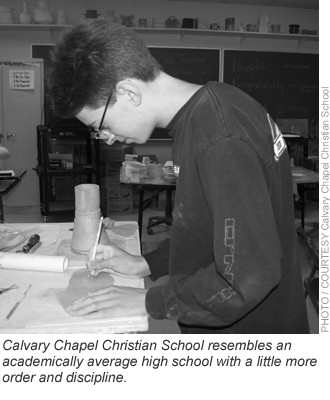 Rejection on Grounds of Religion
Rejection on Grounds of Religion
The science classes from Calvary were rejected by the UC with a simple form letter, one apparently sent to all schools that proposed to use Christian high-school science textbooks published by the two biggest Christian publishers, A Beka Book and Bob Jones University. “The content of the course outlines submitted for approval is not consistent with the viewpoints and knowledge generally accepted in the scientific community,” said the letter. “As such, students who take these courses may not be well prepared for success if/when they enter science courses/programs at UC.” UC’s general counsel, Chris Patti, notes that these texts have many “scientific errors,” and the “biggest one is [the way they describe] evolution.”
Evolution, intelligent design, and creationism are all presented in the Christian biology books. But even if the last two were left out, UC still wouldn’t be satisfied. According to Burt Carney, ACSI’s legal-affairs director, in a meeting held after the rejection of the textbooks, Barbara Sawrey, a professor of chemistry at UC San Diego, explained that there was nothing wrong scientifically with the proposed physics textbook. She simply objected to its including a verse from scripture at the beginning of each chapter.
While controversy over the science requirements turned this lawsuit into another story about evolution and intelligent design for many in the media, the case is, in fact, about much more. The college also objected to one of Calvary’s history courses, “Christianity’s Influence on America,” because, as the UC letter said, the focus was “too narrow/too specialized” and because it is “not consistent with the empirical historical knowledge generally accepted in the collegiate community.” The curriculum of the course seems broad enough—covering the role of Christianity in the founding, the abolitionist movement, civil rights, the fall of communism—but it seems downright all-encompassing when compared, as it was in the complaint, with approved classes like “Modern Irish History” and “Armenian History.”
Calvary’s literature class, “Christian Morality in American Literature,” was rejected because it “does not offer a non-biased approach to the subject matter.” But, as Calvary and ACSI pointed out, the UC approved courses such as “Feminine Perspectives in Literature” and “Ethnic Experiences in Literature.” UC counsel Patti would later try to clarify the rejection by saying that the Calvary course relied solely on works from an anthology. Never mind that the anthology included works by Mark Twain, Stephen Crane, Nathaniel Hawthorne, Edgar Allan Poe, and Walt Whitman.
Ultimately, Patti argues that it is irrelevant whether the UC rejects such courses since other entry methods are available to the Calvary students. UC, he explains, will admit students who score at a certain level on standardized tests, and they may also be admitted by “exception.” Calvary students would thus have to perform in the top 4 percent on exams like the SATII (being in the top 15 percent usually gets you into one of the university campuses). Admission by “exception” is used mostly for home schoolers. The UC system has more than 200,000 students. “Exception” was made for only eight students in the entire system last year.
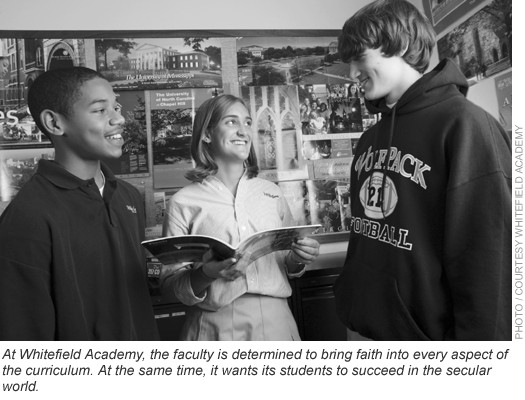
What’s Wrong with God?
Why place this burden on Christian-school students? A UC statement explains that the school’s requirements are there to ensure “that students coming to the University are conversant with accepted educational and scientific content and methods of inquiry at the level required for UC students and typically expected of educated citizens in the competitive workforce.” But Patti acknowledges that there is no evidence that students admitted from schools using these textbooks or offering these courses are performing any differently from their peers in secular high schools. Indeed, juniors at ACSI schools performed between 8 and 27 percentage points above average on the Stanford 10 subject tests in the 2004–05 school year (see Figure 1).
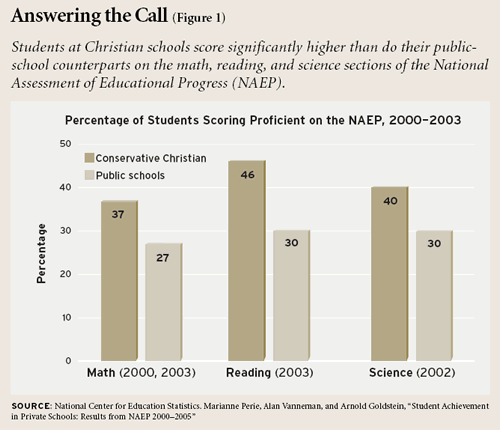
Though UC’s rules aren’t affecting a great number of students right now, because they apply only if a school submits proposals for new curricula, ACSI’s Burt Carney believes it is only a matter of time before the university goes after the 150 or so schools in California that already offer these classes. “Right now, ACSI has distinctively religious schools, which have endeavored to integrate faith and learning in all the subjects,” Carney explains. “If California prevails, the only way for students to go from our schools to university would be to strip out the religious elements of their education.”
Indeed, a list of “helpful hints” from the university suggests stripping religion even out of the religion classes: “Religion and ethics courses are acceptable … as long as they … do not include among its [sic] primary goals the personal religious growth of the student.” This idea would probably sound odd to parents who send their children to any religious school—whether Catholic, Jewish, or evangelical—since character building is one of the foundations of the education excellence these institutions pride themselves on.
Of course, religious schools have always included personal growth among their goals. But just at the time when public universities seem to be taking more precautions against such knowledge (read: moral judgments) creeping into their curricula, evangelical high schools are being more aggressive in practicing what Carney refers to as the “integration of faith and learning.”
For instance, at Whitefield Academy, an evangelical school just outside Atlanta, the faculty is determined to bring faith into every aspect of the curriculum. Stacy Quiros, Whitefield’s band director and one of the school’s founders, explains, “Even though we may be doing algebra, we can say that the wonder of math and the beauty of numbers come from this creative God we serve. Even though we’re studying notes and rhythms, the end result is a sacrifice to God, a sweet aroma.”
But Quiros, who is also the parent of three current Whitefield students and one graduate, says she and the other parents who helped get the school off the ground, in 1996, did not want to sacrifice academic quality in order to have a true Christian school. “We believe that all truth is God’s truth. We were not willing to throw the baby out with the bathwater.”
Until recently Quiros’s statements would have been considered heretical in many evangelical communities, where the faithful tended to subscribe to a creed that Christian historian Mark Noll in his book, The Scandal of the Evangelical Mind, says meant “that we, and only we, have the truth, while nonbelievers or Christian believers who are not evangelicals practice only error.” This led evangelicals to dismiss most secular ideas, explains Noll, a professor at the evangelical Wheaton College, and to fail “notably in sustaining serious intellectual life.”
The notion that faith and learning can coexist has spread to many evangelical colleges in the past few decades and could explain the growing popularity of Christian schooling (see Figure 2). Scholarly pursuits are now seen as a way of glorifying God, both in studying the greatness of God’s world and in developing one’s God-given faculties (an approach to religious education long practiced by Catholic educators). And now these ideas have trickled down to high schools, in part because many Christian-college graduates are choosing to teach at the secondary-school level. Current Christian high school students seem well-versed in the idea of using faith as an inspiration to pursue secular knowledge. Says Jordan Trivison: “Students here bring religion to their attitude toward academics.” As a poster in one of Calvary’s science classrooms puts it, “You need to do all things for the glory of God.”
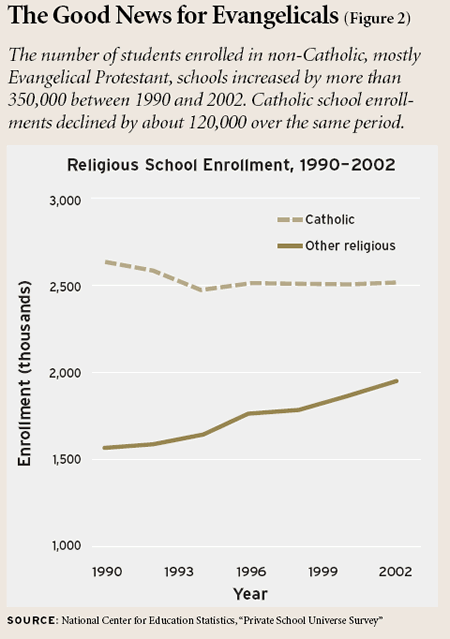
A Cross-Section of Christian Schools
That students work hard is all well and good, but the question of how rigorous this kind of education really is will likely be raised many more times in the coming years. Burt Carney is worried not only that other public colleges might follow the University of California’s lead, but also that groups like the Educational Testing Service are considering classroom visits to make sure that teachers and curricula in AP courses, for instance, meet certain standards. If those standards turn out to be as hostile to religious content as those of UC, then ACSI schools have reason to worry.
What visitors to Christian high school classrooms would find, however, might surprise them. Though evangelical schools remain resolute in their adherence to Christian doctrine, they are also maintaining their academic rigor. I visited three fairly typical schools, Calvary, Whitefield, and Colorado Springs Christian School, and it was clear that much more was being taught than Matthew, Mark, Luke, and John.
Calvary Chapel, with a few stars like Jordan, resembles an academically average public high school. There is probably a little more order and discipline at Calvary than in a typical public school, but Calvary’s students work hard, and they learn math, history, and science from competent teachers. Most of Calvary’s college-bound graduates (about half the senior class) go to public colleges, and for most of those, UC Riverside is about as good as they get.
Whitefield, on the other hand, looks very much like a New England prep school. Both the campus and its 1,200 kids are clean-cut; uniforms are required. Though no one at the school was willing to say that Whitefield youth are perfect, there seemed to be a general agreement that, as biology teacher Christopher McDonald puts it, “You would find a much lower incidence of drug use and sexual promiscuity here” than at other local private and public schools.
McDonald is quick to say that that is not simply the result of Whitefield’s Christian bent or even because its students must sign on to a fierce honor and disciplinary code. Rather, he says, “This school is an extension of the family. They’re in this environment during the day and then they go home to strong Christian families at night, and on the weekends, they’re attending church.”
This is not just speculation. Whitefield considers itself a “covenant school,” meaning that, according to the school’s policy manual, “at least one parent or guardian (and preferably both parents or both guardians) professes faith in the Lord Jesus Christ as his or her personal Savior.” Indeed, at many ACSI schools it is not only the parent but also the student who must provide such Christian “testimony” in the application process. Without it, school administrators believe, the religious identity of the institution will be watered-down over time.
Whitefield has watched as many of the older Christian high schools in the area have become increasingly secular—largely indistinguishable from other private high schools. Whitefield wants to avoid such a fate. At the same time, though, it wants its students to be able to succeed in the secular world. And that is why it is so important to Whitefield parents and administrators for the school to gain a good academic reputation as well.
It seems to have succeeded on the academic front. An English teacher speaking about Huck Finn to a class of seniors compares Tom’s character to the Devil’s in Paradise Lost, a reference that the kids understand because they had read Milton the previous year. European history students are studying Holocaust survivor Victor Frankl’s Man’s Search for Meaning, because, as teacher Amy Seefeldt explains, even though Frankl is an atheist, “He says that at the core of human existence is the search for meaning.” In all of her history classes, Seefeldt tries to show students how this is “what every civilization has been searching for.” Students are doing well on AP and SAT tests and being accepted at top colleges, including Boston College, Baylor, Pepperdine, Duke, Washington and Lee, and Dartmouth.
Whitefield’s headmaster, Tim Hillen, acknowledges the difficulty in getting people to take a relatively new and strongly Christian school seriously. But, he says, “The proof is in the pudding. We have the actual statistics, and the education achievement is here.”
Colorado Springs Christian School (CSCS) falls somewhere between Whitefield and Calvary in the ranks of ACSI schools. It is bigger than both (with 1,700 students) and was founded in 1971, before either one. The school has a dress code, which prohibits such religious fashion no-nos as “excessive sagging” on men’s pants, but it is easy to spot boxer shorts, bra straps, and all sorts of other signs of immodesty among students strolling the campus. Though the vast majority of the students do go on to college, they generally go to less-impressive schools than students who matriculate from Whitefield. Many students plan to attend public institutions nearby, such as the University of Colorado. The environment is not heavily intellectual; the principal used to be an athletics coach. His office doesn’t have many books, but it does have a religious sculpture of two hands, palms facing heavenward, filled with manna for adolescents: miniature candy bars.
Part of what makes CSCS distinctive is a faculty whose members care deeply about their own faith and that of their charges. As history teacher Kris Walker notes, teachers are “definitely not in it for the money.” Students frequently mention how much the teachers at CSCS care about them (and how much they sacrifice to work there). Walker explains the decision she and her colleagues have made to teach at CSCS: “This is where God wants us. We’re here to make eternal differences in their lives, not just get them into college.”
Where to Draw the Line
Other factors bring teachers to CSCS as well. Maryanne Brilleslyper, who has a Ph.D. in choral conducting and has just taken over as the school’s choir director, has taken a pay cut to come here from a public school. She is confident in her decision because, she says, “There’s nothing I can’t sing here. I don’t need school board approval to mention God. I can base my choices on musical merit.” The opportunity to share their religious beliefs in intellectual and emotional contexts is exciting to many of the teachers at Calvary, Whitefield, and Colorado Springs Christian. Their curricula are not censored, at least not for mention of God, and their interactions with students can include helping them through spiritual crises, not just academic ones.
Parents like this aspect of Christian schools, too. Randy LaPierre, who has two sons at Calvary Chapel, says that families are able to have “a certain bond with teachers,” which would allow him to go meet a new teacher, “and after a minute or two, say, ‘Hey, can I pray with you?’ And I can feel his heart will be lined up with my heart.”
In sum, these schools provide students, teachers, and families with a common cause, academically and religiously. One of Whitefield’s more surprising attributes is the school’s racial integration. With minorities composing 20 percent of the enrollment, the school could easily experience the kind of self-segregation that plagues many education institutions. Not only does the Whitefield student body seem cohesive, but the black students are achieving at high levels. An AP biology class of 12, for instance, has 5 black students.
A school’s willingness to define its boundaries, however exclusionary they may seem to outsiders, can have clear benefits for education. Perhaps the most interesting illustration of this idea comes from a story Stacy Quiros tells about a Buddhist woman who wanted to send her kids to Whitefield.
“I started talking to her about her faith,” says Quiros. “I said, ‘You’re going to have a hard time reconciling the fact that we believe that Jesus Christ is the Lord and Savior and there is only one way to salvation with your own beliefs.’” When the woman told Quiros that her son could “learn that stuff too,” Quiros asked, “What are you going to do when your son comes home and says, ‘This is what I’m being taught?’ Isn’t that going to be a conflict?” The mother shrugged, “Well that’s just school.” With little fanfare, Quiros replied, “No it’s not.”
Perhaps there’s a lesson there for all schools, including universities, which try so earnestly to divorce the dissemination of knowledge from the shaping of character. Such distinctions are not so easily made. Students take their moral lessons where they can find them.
-Naomi Schaefer Riley is the deputy editor of the Taste page at the Wall Street Journal and author of God on the Quad: How Religious Colleges and the Missionary Generation Are Changing America.


